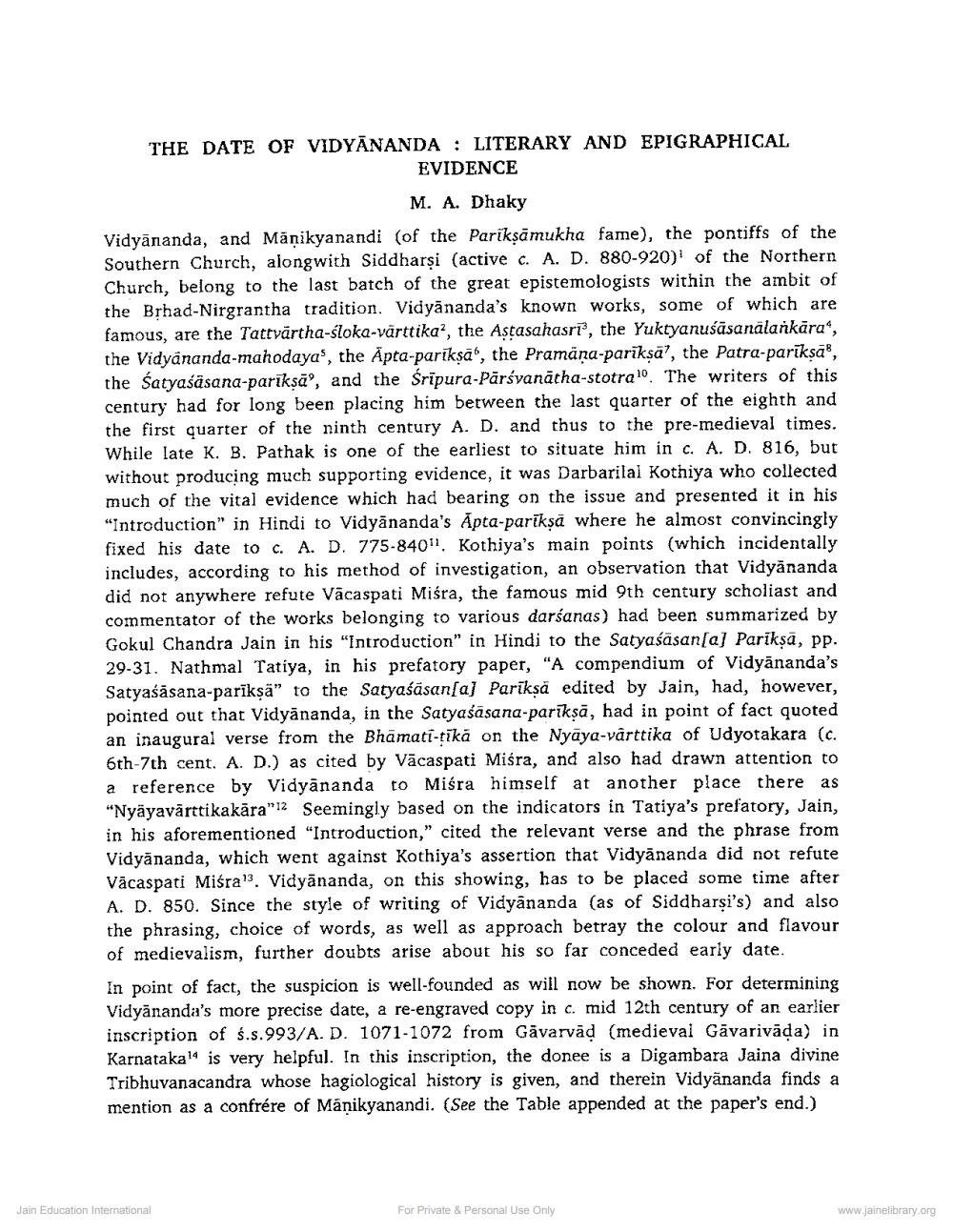Book Title: Date of Vidyananda Literary and Epigraphical Evidence Author(s): M A Dhaky Publisher: Z_Nirgrantha_1_022701.pdf and Nirgrantha_2_022702.pdf and Nirgrantha_3_022703.pdf View full book textPage 1
________________ THE DATE OF VIDYANANDA : LITERARY AND EPIGRAPHICAL EVIDENCE M. A. Dhaky Vidyānanda, and Māņikyanandi (of the Parikṣāmukha fame), the pontiffs of the Southern Church, alongwith Siddharşi (active c. A. D. 880-920)' of the Northern Church, belong to the last batch of the great epistemologists within the ambit of the Brhad-Nirgrantha tradition. Vidyānanda's known works, some of which are famous, are the Tattvārtha-śloka-vārttika?, the Aștasahasri, the Yuktyanusāsanālankāra", the Vidyananda-mahodaya', the Apta-pariksa", the Pramāna-parīksa', the Patra-parīksa, the satyaśāsana-parīksā', and the Śrīpura-Pārsvanātha-stotra. The writers of this century had for long been placing him between the last quarter of the eighth and the first quarter of the ninth century A. D. and thus to the pre-medieval times. While late K. B. Pathak is one of the earliest to situate him in c. A. D. 816, but without producing much supporting evidence, it was Darbarilal Kothiya who collected much of the vital evidence which had bearing on the issue and presented it in his "Introduction" in Hindi to Vidyānanda's Apta-parīksa where he almost convincingly fixed his date to c. A. D. 775-840" Kothiya's main points (which incidentally includes, according to his method of investigation, an observation that Vidyānanda did not anywhere refute Vācaspati Miśra, the famous mid 9th century scholiast and commentator of the works belonging to various darśanas) had been summarized by Gokul Chandra Jain in his “Introduction" in Hindi to the Satyaśāsan[a] Parikṣā, pp. 29-31. Nathmal Tatiya, in his prefatory paper, "A compendium of Vidyānanda's Satyaśāsana-pariksä” to the Satyaśāsan[a] Parīksă edited by Jain, had, however, pointed out that Vidyānanda, in the Satyaśāsana-parikṣā, had in point of fact quoted an inaugural verse from the Bhamati-tīkä on the Nyaya-vārttika of Udyotakara (c. 6th-7th cent. A. D.) as cited by Vācaspati Miśra, and also had drawn attention to a reference by Vidyānanda to Miśra himself at another place there as "Nyäyavārttikakāra"12 Seemingly based on the indicators in Tatiya's prefatory, Jain, in his aforementioned "Introduction," cited the relevant verse and the phrase from Vidyānanda, which went against Kothiya's assertion that Vidyānanda did not refute Vācaspati Miśra"3. Vidyānanda, on this showing, has to be placed some time after A. D. 850. Since the style of writing of Vidyānanda (as of Siddharși's) and also the phrasing, choice of words, as well as approach betray the colour and flavour of medievalism, further doubts arise about his so far conceded early date. In point of fact, the suspicion is well-founded as will now be shown. For determining Vidyānanda's more precise date, a re-engraved copy in c. mid 12th century of an earlier inscription of ś.s.993/A. D. 1071-1072 from Gävarvad (medieval Gāvarivāda) in Karnataka! is very helpful. In this inscription, the donee is a Digambara Jaina divine Tribhuvanacandra whose hagiological history is given, and therein Vidyananda finds a mention as a confrére of Manikyanandi. (See the Table appended at the paper's end.) Jain Education International For Private & Personal Use Only For Private & Personal Use Only www.jainelibrary.orgPage Navigation
1 2 3 4 5 6 7 8
